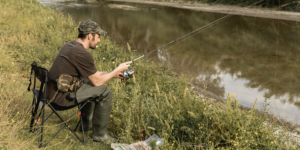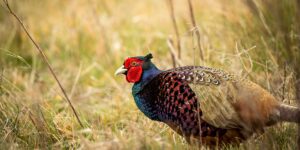Quail are arguably the most recognized upland bird and a fun species to pursue for both experienced and novice hunters.
Hunting quail, America’s most iconic game birds, is a past-time long steeped in tradition. Different species of quail roam from south Georgia to California, and provide quail hunters with a challenging hunt and excellent table fare.
Whether you’re looking to hunt quail country for the iconic bobwhite in the red clay of the Georgia pines on horseback, or the rugged desert for mearns quail, read on for your guide to becoming a better quail hunter.
Why limit yourself to public land when there are millions of acres of private land to explore.
Best Habitat for Quail Hunting
Quail habitat varies by the species you plan to hunt, although depending on location, habitats can be similar. Quail typically live out there lives (which are often short) within a small home range of around 40 acres. In general, like other upland game birds, quail prefer cover that gives them access to the bare ground to scratch for feed and move around easily, while also being protected from predators. Quail country generally consists of low woody brush or thick bushes for protection while they forage. Birds also prefer bunch grasses, meadows, shelterbelts, crop fields, and close to water sources such as river bottoms or lake edges in woody brush.
Popular Types of Quail to Hunt
There are six native species of quail found in North America. Each have unique plumage and characteristics, and each are dispersed across the country in varying regions.
Arguably the most recognizable game bird, outside of pheasants, to most hunters, the bobwhite quail is iconic to the eastern, midwest, and southern half of the United States. A ground dwelling bird, male bobwhite quail have a white throat and a brow stripe that is bordered by black; the female bobwhites are all brown. Bobwhites are known for their unique whistling call.
If quail hunters move further west, they will find the other five species of quail. Most notable of the western five is the California quail, also known as the valley quail. California quail are found in the foothill forests of California and the Northwest. They have a unique plume atop their head that droops forward. Also notable is the Gambel’s quail that looks similar to California quail, but are a desert quail and found in the southwest. They have a scaly plumage and a top knot on their heads.
Scaled quail, also known as blue quail, can also be found in the southwest. They are known for the blue scaled like feathers, and a white crest atop their head. Another iconic southwestern bird is the Mearns quail. Also known as Montezuma quail or harlequin quail, they are found in a small range in the southwest and are very unique. Male mearns have white and black harlequin-marked heads, and white spotted black flanks that look similar to a guinea fowl’s plumage. And finally, the Mountain quail is the largest of the quail species and is easily recognized by the two straight feathers that stick out from their head and arch over their back.
Quail Hunting Strategies
Quail typically are found in coveys ranging from 8 to 10 birds, all the way up to 25 birds. As mentioned above, a covey of quail typically stay within a small range when they find food, cover, and water.
Look for what quail want the most: shrubby cover, herbaceous vegetation such as tall grasses and shrubs, and bare ground such as that between plants. Quail eat not only insects, but heavily rely on seeds, berries, and even leaves.
Quail will feed twice a day, with their first coming in the early morning, and afternoon feeding sessions happening mid to late in the day. Don’t plan on hunting at first light for quail. If it’s cold, quail will sit tight and wait for the sun to warm things up before they start feeding. Look for shrubby habitat in the mid-morning, such as shelterbelts or low lying areas like river bottoms. Later in the afternoon, you may find quail feeding in more open areas, or near crop edges.
A quail covey busting from the brush in front of you is exciting but can often come as a surprise, throwing hunters for a curveball. Instead of shooting at the entire covey and “flock shooting,” take your time and pick one bird out of the group. Focus on the bird before pulling the trigger for a greater chance as hitting your target.
After a covey flush, quail will disperse into singles. This gives you a greater opportunity to bag a bird, but avid quail hunters and conservationists will advise against taking too many singles from a covey. Quail are very fragile wild birds, and killing too many from one covey can put the entire group at risk. Instead of trying to reach your bag limit on a single covey, take one from the group and move on to a different area. It’s also important not to hunt a covey in the evening after you have flushed them. Evenings are when quail will regroup to roost together. The more pressure you put on them, the less likely they are to regroup, and that puts the safety of the covey at risk.
The hassle free way to monetize your acreage.
Best States for Quail Hunting
Luckily for hunters wanting to pursue this wild bird, quail range in different regions of the U.S. and quail hunting can be done in many states depending on species.
The Southeast, particularly Georgia, is a favorite among bobwhite quail hunters, and is backed by tradition. Hunts are often done on plantations and from horseback. Bobwhites can also be found a little more north in Kentucky.
In the midwest, bobwhite quail hunters should set their sights on Kansas, Missouri, and even Iowa. Although bird numbers are better than some depending on state, bobwhite range throughout these midwestern states.
The plains of Oklahoma are iconic for bobwhite quail, while Arizona features quail habitat that is home to Gambel’s, scaled, and mearn’s quail. New Mexico is also where hunters head to hunt mearn’s for a chance at the fool’s quail.
Head a bit north to Idaho for California quail, while Oregon is home to the elusive mountain quail.
Great States for Upland Bird Hunting
Where to go Quail Hunting: Public vs Private Land
Quail hunts can be done on both public and private land. As with all bird hunting, success is dependent on hunting pressure put on the birds, habitat, and bird numbers in the area.
Public Land: Hunting wild quail on public land is free to hunters who want to pursue them. Millions of acres of public land can be hunted, but this can put a lot of foot traffic in areas that have quail habitat. That means quail may feel the pressure from being pursued, and can move to private land where they are safer from you, the predator.
Private Land: Gaining access to private land can give hunters a leg up and a better chance at hunting less-pressured quail. Because access to private land may only be given to a handful of individuals, birds may not be pushed to different properties and will call their home range home on the private land you have access to. This gives you better opportunities to bag a bird or two.
Affordable Private Land Access: Wing It offers hunters a way to hunt private land and gain more access to wild birds. Hunters can reserve the right to hunt private land by simply finding land in their area, and paying a small usage fee for the day. A membership to Wing It gives hunters discounts on access fees, while non-members can still reserve prime hunting land, just at an additional fee.
Why limit yourself to public land when there are millions of acres of private land to explore.
Quail Hunting FAQ
Is quail hunting difficult?
Quail hunting can take hunters over varying terrain; from rolling plains to desert like environments. Hunters can often put many miles on the boots, and spend many hours afield. For safety, ensure you are prepared to hike, have quality boots that you have broken in, and are dressed for the varying weather temperatures.
Do you need a dog to hunt quail?
You do not need a dog to hunt quail, however, bringing a gun dog afield does give you an advantage. Quail are very small upland birds, and when they fall in thick cover, they can be hard to locate and recover. A dog’s keen sense of smell can not only help you find more birds, but also find them after the shot.
When is quail hunting season?
Wild quail hunting season range from state to state. Generally, season start in early November and close in late December, but in the southwest, seasons can last till late January and mid February. It’s important to check state regulations before heading afield.
How many quail can you shoot?
Take one or two from the group, and move to a different area. Check state regulations for bag limits before heading to hunt.
Can you shoot quail on the ground?
bird should be shot on the ground for both ethical and safety reasons. Allow quail to take flight and gain a safe height before taking a shot.



